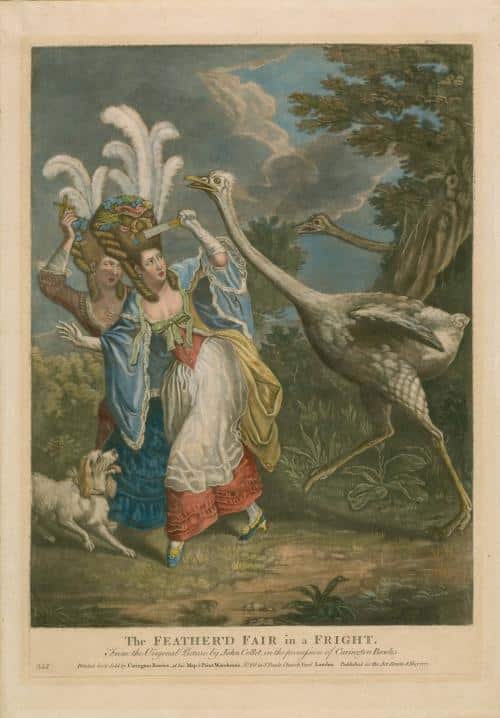Birds and Animal Art
The Inclusion of Foreign Avian Species in Gould’s Birds of Europe
A consideration of Gould’s inclusion of non-native birds in his monograph on European species and the significance underlying the availability of exotic avifauna in the European market.
When browsing the contents of John Gould’s compendious Birds of Europe, the majority of the prints depict birds that we would expect to find in a monograph on the avifauna of the European continent. But amongst the familiar depictions of starlings, magpies, and moorhens, Gould has included several avian species that are not native to Europe. Examples of these foreign species include the Egyptian Goose, Numidian Demoiselle, and Ruffed Bustard, to name but a few. While Gould’s creative decision to include foreign but naturalized bird species in his European taxonomy is not unheard of, it reflects a unique perspective on species dispersal that runs parallel to the interests, networks, and economic exploits of the British Empire during this time. This essay will consider the varying motivations behind Gould’s decision to include representations of naturalized avian species in his folio as well as the significance behind the availability of exotic avian species in the Western European market.
To begin with, John Gould lived in London during the 19th century at a time when the British Empire was rapidly expanding through its colonial exploits and increasingly globalized trade networks. Consequently, it is not difficult to imagine that the British colonial mentality, which sought to expand the empire’s influence and access to resources, permeated Gould’s own approach to establishing the parameters of his folio. This parallel attitude can be seen in Gould’s willingness to represent exotic avian species that had been or were in the process of becoming naturalized in Europe.
Take for example Pl. 353 the Egyptian Goose, drawn by Edward Lear for Gould’s publication, and printed through lithography with hand-applied color. While native to Africa, the species was known to frequent European soil. Gould uses the bird’s recreational tendency to substantiate his decision to include the Egyptian Goose as a “member of the European Fauna”, stating that the species “occasionally visit[s] the southern parts of the Continent from its native country Africa” (Gould, Birds of Europe). In Gould’s eyes, the goose’s seasonal vacation to European soil is enough to warrant its inclusion in European ornithology. In this way, Gould’s boundaries for his folio are flexible and demonstrate a willingness to expand.


Gould’s expansionist approach to defining the borders of his artistic project runs parallel to the intentions of the British Empire at this time, which, in addition to numerous other exploits, sought to expand trade networks and acquire colonies. As a result of Britain’s agency in globalized trade during the 19th century, a great number of exotic plants and animals became available on the European market. Included amongst these foreign imports were birds such as the Egyptian Goose and Numidian Demoiselle which were desirable as ornaments for the pleasure gardens, aviaries, and menageries of wealthy individuals. Predictably, there is a direct correlation between the reach of the British Empire and the types of flora and fauna imported for domestic sale. This, in turn, indicates the direct impact of human intervention on the spread of certain exotic species outside their native habitat. As Christopher Plumb argues in his thesis Exotic Animals in Eighteenth-Century Britain, the availability of exotic species in Britain was directly “commensurate with territorial gains and commercial expansions” (Plumb 2010, 55).

The Feather’d Fair
A satirical print from 1777 England depicts two ladies running from a pair of curious ostriches that are intrigued by the familiar feathers decorating the lady’s hats. The ostriches are representative of the types of ornamental avifauna that could be found in 18th and 19th-century menageries.
Regarding the inclusion of the Numidian Demoiselle in Birds of Europe, Gould explains his decision by stating that the bird “is very common along the whole of the African Coast of the Mediterranean; we need not therefore be surprised at its being included in the Fauna of Europe, as its great powers of flight would readily enable it to cross the Mediterranean; and this we find to be the case…[as] it is found in the southern plains about the Black and Caspian Seas…” (Gould, Birds of Europe). Despite its definitive origin outside of Europe, Gould welcomes the exotic species into the European ornithological repertoire.
While on the one hand, we can applaud Gould’s openness in accepting foreign species into a European taxonomy. On the other, when viewed against the backdrop of 19th-century political and economic history, Gould’s inclusion of exotic species holds a despotic tenor and could be read as an attestation of ownership that parallels the colonizing sentiments of certain imperial European powers at this time.



